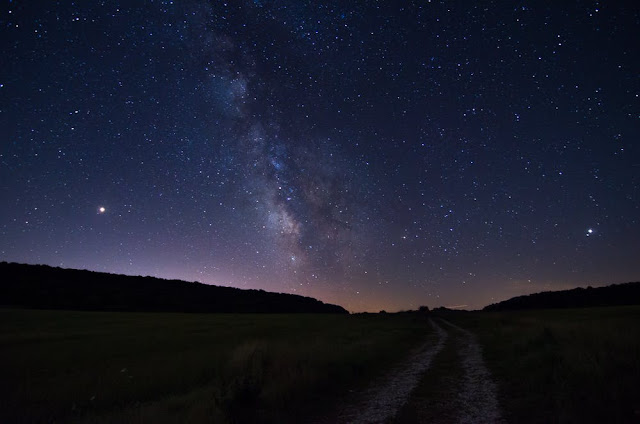Universe size
The universe has long captivated us with itsimmense scales of distance and time. How far out does it stretch?
As a result :-
according to Guth’s calculation,the universe as a whole would have grown to some ten billion trillion times the size ofthe observable universe. That’s a ten followed by 24 zeroes. Put another way, the whole universe is tothe observable universe - as the observable universe is - to an atom. The incredible fury of cosmic inflation helpsexplain the immense size and smoothness of the universe. But to succeed, the theory must also accountfor how the universe produced what we see around us, all those stars and galaxies andclusters of galaxies, and ultimately us.
Scientists are now attempting to piece togetherthe chain of events that launched our universe in its earliest moments by generating whatyou might call a “little bang.” At the Brookhaven National Lab in New YorkState, they are blasting gold atoms in opposite directions down tunnels almost two and a halfmiles long.
When these atoms reach velocities just shortof the speed of light, they are sent into a violent collision. A fireball erupts, reaching a temperature exceeding two trillion degrees Centigrade. As far as we know, the last time anythingin our universe was that hot was about a millionth of a second after its birth.
What interests the scientists is the splatterof subatomic particles, a super-hot soup of quarks and gluons that theory says gave riseto matter as we know it. In initial tests, this quark-gluon plasmahas shown a crucial property: extremely low viscosity or resistance to flow.
Scientistscall it a perfect liquid. To grasp its importance, we go back to thoseprimordial energy fields that the theory says spawned the big bang. The thinking is thatthose fields contained tiny fluctuations that were blown up to huge size during inflation. In the ultra-dense quark-gluon mix, thesefluctuations generated pressure waves, or ripples. As the universe evolved, these ripplesgave rise to variations in the density of matter.
Amazingly, the imprint of those primordialripples is out there today in a gaint signal discovered accidentally back in the 1960s. Working for the Bell Telephone Company, physicistsArno Penzias and Robert Wilson had built a giant horn-shaped antenna.
But wherever theypointed, the contraption picked up excessive noise in the microwave portion of the electromagneticspectrum. That noise turned out to match a predictionmade years earlier: that in the wake of the big bang, the universe was filled with a cloudof extremely hot gas that scattered all light. As the universe cooled, the cloud dissipated.Light then shone through Over time the spectral signature of this lightwould have shifted, as the universe expanded and cooled, to what Penzias and Wilson detected.
What they’d heard was the echo of the Big Bang. This image shows the smooth contours of thelight recorded by the Bell team. Scientists would have to look closer to find the imprintof cosmic inflation. The Space Shuttle Discovery lifted the HubbleSpace Telescope into orbit on April 24, 1990, in one of the most important scientific milestonesof our time. Another launch, arguably just as important,took place five months earlier.
The Cosmic Observation Background Explorer,COBE for short, was sent up to take a harder look at the microwave radiation discoveredby Penzias and Wilson. The results came out two and a half yearslater. The light of the early universe contained a pattern of hot and cold spots. In this image was nothing less than the originof all we see around us today, smooth on a large scale, but with significant clumps fromwhich gravity would form gas clouds, then stars, and galaxies. With this cosmic template in hand, astronomersset out to discover how the patterns and the dimensions of the universe evolved over time.
In an age of computer controlled telescopesand automated observing, astronomers could now launch huge international collaborationswith the goal of mapping a large fraction of the universe in three dimensions. At Apache Point in New Mexico, the Sloan DigitalSky Survey set the standard for mass production astronomy. A series of steel plates are drilled withholes that exactly match the location of galaxies in the night sky.
After plugging fiber optic sensors into theholes, the plates capture the light of hundreds of galaxies per night. From that light theastronomers calculate their distances from Earth. Another survey is named the 2 Micron All SkySurvey, or 2Mass, after the frequency of infrared light its detectors are tuned to capture. In this image, the 2Mass data covers a region60 million light years across. The local group of galaxies, including the Milky Way, arein the center.
This is our intergalactic neighborhood. Jump further out to a region about 200 millionlight years across. Our location is linked to the densely packed Virgo Supercluster,the nearest intergalactic city. Stepping out to a region over 320 millionlight years across, you can see the full breadth of our local region of the universe. Galaxiesline up in walls and arcs. Beyond them are sparsely-populated voids, the rural cosmiccountryside. Moving out with the data, this region is over650 million light years across.
Then almost two billion. 3.2 billion. And finally out to a region 6.5 billion lightyears from end to end: the cosmic continent. In the middle of it all, our galaxy, so immensefrom our Earthly perspective, is less than a speck. The 2mass study, the Sloan Digital Sky Survey,and the 2 Degree Field in Australia have extended our maps to a quarter of the way back to thebeginning of the universe.
They have laid out a grand cosmic roadmap. COBE’s successor, the Wilkinson MicrowaveAnisotropy Probe, or “WMAP”, was launched to scan the early universe for the fine-scale origins of this cosmic atlas. WMAP traveled beyond any interference fromEarth, to a position balanced between the Earth and the Sun. There, for two years, its detectors took inthe pristine light of deep space.
This is what WMAP saw: a pattern consistentwith the filaments and voids that had evolved in the universe at large. Scientists are poring over the WMAP data forclues to the true dimensions of the universe. One group, for example, looked for repeatingpatterns that could be evidence of pressure waves that ricocheted through the hot gasof early times. They saw none, which implies that the universehad grown so large during inflation that such waves could not cross it.
Then they did the math and reported that theentire universe must have a minimum diameter of 78 billion light years. So what is its maximum size, and what’sbeyond that? We will never know for sure what lies beyondour visual horizon, but astronomers are turning up some surprising hints in the universe theycan see. To ancient observers, the universe was madeof five classical elements: Earth, Water, Air, Fire, and a fifth, Quintessence, or space. Aristotle believed the stars, unchanging andincorruptible, were made of this fifth element.
Today, we are finding that space, in fact,has a character of its own. Astronomers have calculated the gravitationalpull needed to bind stars as they orbit a galaxy or galaxies as they orbit a clusterof galaxies. They have found that there is simply nowherenear enough visible matter there to hold these structures together. The missing ingredient, its identity stillunknown, they call: Dark Matter.
In supercomputer simulations of cosmic evolution,dark matter is added in to supply the gravitational tug needed to form the web pattern of filamentsand walls; voids and dense clusters we see in the universe at large. But something else appears to be happeningon these large scales. Astronomers have been making refined measurementsof the cosmic expansion rate with a new type of distance marker.
They wanted to know if gravity was slowingdown the pace at which the universe is growing. The markers they used, type 1A supernovae,are thought to burn at uniform intensities throughout the universe. By measuring changes in the brightness ofthese so-called standard candles at various distances, the researchers can spot changesin the cosmic expansion rate. To their surprise, the data showed that theuniverse as a whole is not only expanding, it’s actually accelerating outward! The culprit is thought to be energy wellingup from the vacuum of space, similar to what occurred in the early moments of the Big Bang,causing cosmic inflation.
By emerging in minute quantities everywhere,it is pushing space outward across the whole universe. Over time, this so-called “Dark Energy”has grown to an astonishing three-fourths of all the matter and energy in the universe. With data like this pointing to an underlyingdynamic within our universe, some scientists are thinking of the cosmos in far broaderterms than ever before.
There is a version of inflationary theory,for example, that suggests we live in one of many universes, that may co-exist sideby side but do not touch one another. Like bubbles, they are continually risingup and expanding across the oceans of infinity. Just 500 years ago, in Galileo’s time, manypeople looked out into space and saw a universe of lights centered on the Earth. The invention of the telescope revealed starsfar from our planet, then galaxies, clusters of galaxies, and beyond them, vast walls andfilaments of matter.
Newer ideas about the size of the universeamount to a quantum leap in our sense of scale, by extending these structures far, far beyond our horizon. Do these discoveries push us, on our tinyout-of-the-way planet, into a smaller and smaller corner of Creation? Or does our ability to comprehend and imaginethe far limits of time and space somehow expand our importance in the grand scheme of things?
You can also read about sun and moon facts and information.👇








Comments
Post a Comment